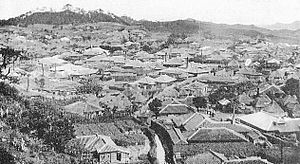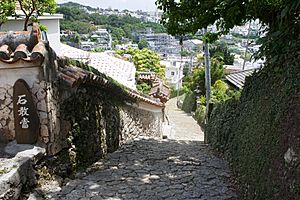Shuri facts for kids
Shuri is a special area in the city of Naha, Okinawa, Japan. It used to be its own city and was the royal capital of the Ryūkyū Kingdom for a long time. Many famous historical places are in Shuri. These include Shuri Castle, the Shureimon gate, Sunuhyan-utaki (a sacred place for the local Ryukyuan religion), and the royal tomb Tamaudun. All these sites are recognized as World Heritage Sites by UNESCO.
Shuri started as a town built around the royal palace. It stopped being the capital when the kingdom became part of Japan as Okinawa prefecture. In 1896, Shuri became a part of Naha. Later, in 1921, it became a separate city again. But in 1954, it joined Naha once more.
Contents
History of Shuri
Early Times and the Ryukyu Kingdom
Shuri Castle was first built a very long time ago, around the years 1237–1248. This was when Shunbajunki was in charge from a nearby castle called Urasoe. At that time, Okinawa Island was not one big kingdom. It was a group of small areas led by local chiefs.
A historian named George H. Kerr said that Shuri Castle is "one of the most magnificent castle sites to be found anywhere in the world." This is because it sits high up and lets you see the land for miles around, as well as the sea in every direction.
By 1266, Okinawa was collecting gifts and payments, called tribute, from nearby islands like Iheya and Kumejima. New offices were set up at the port of Tomari to handle these payments. Tomari was just below the castle.
Shō Hashi became the first king of the united Ryūkyū Kingdom. He made Shuri his capital and worked to make the castle and city bigger and better. Shuri stayed the royal capital for about 450 years. The castle was burned down in the 1450s during fights over who would be king. But it was rebuilt.
King Shō Shin (1477–1526) made the castle and city even more beautiful. He added stone dragon pillars to the palace. A Buddhist temple called Enkaku-ji was built on the castle grounds in 1492. The Sōgen temple was also made larger. In 1501, the royal tomb Tamaudun was finished. It was used to bury the kings and queens from then on.
For many centuries, the people who lived in Shuri were mostly connected to the royal family. While Naha was the main place for business, Shuri was the center of government. Living in Shuri was seen as a sign of importance even into the 1900s.
In 1609, samurai warriors from a Japanese area called Satsuma took over Shuri Castle. They left soon after, and King Shō Nei returned to his throne. The kingdom became a vassal state of Satsuma. This meant it was still a kingdom but had to follow Satsuma's rules. This lasted for about 250 years. Later, in the 1850s, an American, Commodore Perry, visited Okinawa. He entered Shuri Castle twice but was not allowed to meet the king.
Shuri Under Japanese Rule

The Ryūkyū Kingdom officially ended on March 27, 1879. Japanese forces went to the castle and told Prince Nakijin that Tokyo had decided to take over. King Shō Tai and his court had to leave the castle. Japanese soldiers then took over the castle and closed its main gates.
After this, the castle and the homes of the former nobles in Shuri started to fall apart. The way of life for the noble families in Shuri was completely changed. Their royal payments were cut or stopped. Many nobles lost their servants and had to find jobs in Naha or other parts of Japan.
In the late 1870s, about half of the people on Okinawa Island lived in the Naha-Shuri area. Shuri had fewer homes than Naha, but each home had more people. Most of the noble families lived in Shuri. However, over the next few years, Shuri became less important, and Naha grew bigger.
People started to push for the historical sites in Shuri to be saved and protected in the 1910s. In 1928, Shuri Castle was declared a National Treasure. A plan was made to restore the castle over four years. Other historical places were also protected soon after.
During World War II, Shuri Castle and the tunnels under it were used as headquarters for Japanese military forces in Okinawa. The city was first attacked by Allied planes in October 1944. People living in Shuri were not well prepared for these attacks. Many officials did not do enough to protect civilians or historical buildings. People had to try to save themselves and their families.
In March 1945, the person in charge of the Okinawan royal family's treasures returned to their homes in Shuri. They tried to save many valuable items, like crowns and royal portraits. Some items were hidden in vaults, while others were buried in the ground around Shuri. The royal homes were destroyed by fire on April 6.
Shuri was a main target for American forces during the battle of Okinawa in 1945. This was because it was the center of the Japanese defense. Shuri Castle was destroyed by the USS Mississippi battleship. Much of the city was burned and ruined during the battle.
After the War
The city of Shuri was rebuilt in the years after the war. The University of the Ryukyus was started on the ruins of Shuri Castle in 1950. The university later moved to other locations. The castle walls were rebuilt soon after the war ended. The main hall of the palace, called Seiden, was finished in 1992. This was 20 years after the American forces left Okinawa.
Education in Shuri
Shuri has many schools, including primary, middle, and high schools. It also has a university. The Okinawa Prefectural University of Arts is located very close to Shuri Castle. One of the university's buildings is on the site where the royal administration's office for craftsmen used to be. This office oversaw artists who made things like Ryukyuan lacquerware.
The village of Tobari in Shuri was the home of Masami Chinen. He created and taught a martial art called Yamanni ryu. This art focuses on using a long staff, called a bō.
Getting Around Shuri
The Okinawa Urban Monorail has two stations in Shuri: Gibo and Shuri Station. Shuri Castle Park, Tamaudun, and other important places are easy to walk to from Shuri Station. Shuri Station is currently the last stop on the monorail line, but there are plans to make it longer in the future.



